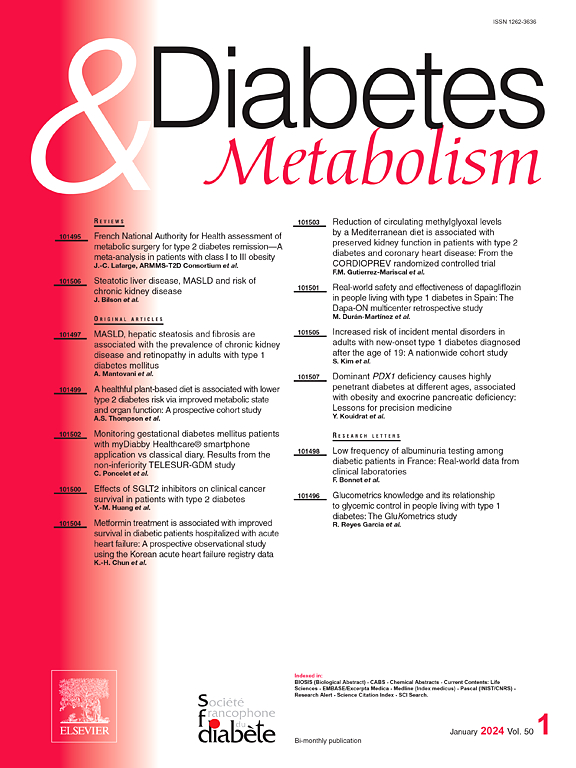GLP-1受体激动剂,身体成分,骨骼肌和肌少症的风险:从动物模型的有希望的发现到人类研究中有争议的问题
IF 4.7
2区 医学
Q1 ENDOCRINOLOGY & METABOLISM
引用次数: 0
摘要
背景。-以胰高血糖素样肽-1 (GLP-1)为基础的治疗可诱导临床相关的体重减轻,这与2型糖尿病和/或临床肥胖患者的总体预后较好相关。然而,过度减少无脂肪量(FFM)和骨骼肌量(SSM)的风险,可能导致高危患者的肌少症,目前是一个有争议的问题,因为这种负面影响可能会使他们的利益/风险平衡最小化。方法。-广泛的文献检索,以检测基于glp -1的治疗对身体成分(FFM和SMM)、肌肉力量、结构和功能变化的影响的动物和人类研究。结果。-在不同的啮齿动物模型中,glp疗法对SMM、肌内脂质沉积、炎症和线粒体健康均有良好的影响。然而,在人体研究中报告了不同的结果,一些报告了过度的FFM/SMM损失,而另一些则认为对肌少症有保护作用(包括减少肌骨化病)。这一争议可能源于对源自FFM变化的SMM的误解,以及缺乏适当研究人类SMM、肌肉功能和结构的研究。结论。-最大限度地减少脂肪,同时保持瘦(肌肉)组织的质量和功能是现代肥胖药物治疗的中心目标。目前,现有的数据排除了对基于glp -1的治疗对肌肉的正面或负面影响的明确结论。为了更好地分析基于glp -1的治疗的效果,特别是在肌少症高风险人群、老年患者和体弱人群中,需要使用准确的方法进行进一步的研究,不仅要评估SMM,还要评估肌肉结构、功能(力量)和表现。本文章由计算机程序翻译,如有差异,请以英文原文为准。
GLP-1 receptor agonists, body composition, skeletal muscle and risk of sarcopaenia: from promising findings in animal models to debated concern in human studies
Background. - Glucagon-like peptide-1 (GLP-1)-based therapies induce a clinically relevant weight loss, which is associated with overall better prognosis in people with type 2 diabetes and/or clinical obesity. However, a risk of excessive reduction in fat-free mass (FFM) and skeletal muscle mass (SSM), potentially leading to sarcopaenia in at-risk patients, is currently a matter of debate as this negative effect could minimize their benefit/risk balance. Methods. - An extensive literature search to detect animal and human studies that investigated the effects of GLP-1-based therapies on changes in body composition (FFM and SMM), muscle strength, structure, and function. Results. - Favourable effects on SMM, intramuscular lipid deposition, inflammation and mitochondrial health were consistently reported in different rodent models with GLP-based therapies. However, mixed results were reported in human studies, some reported an excessive FFM/SMM loss while others arguing for a protective effect against sarcopaenia (including less myosteatosis). This controversy may result from misinterpretation of SMM derived from FFM changes and a lack of studies that properly investigate SMM, muscle function and structure in humans. Conclusion. - Maximizing fat loss while preserving lean (muscle) tissue mass and function is a central goal of modern obesity pharmacological treatments. Currently, available data preclude to have a definite conclusion about positive/negative effects of GLP-1-based therapies on muscle. Further investigations using accurate methodologies to assess not only SMM but also muscle structure, function (strength) and performance are needed to better analyse the effects of GLP-1-based therapies, especially among individuals at higher risk of sarcopaenia, older patients and frail people.
求助全文
通过发布文献求助,成功后即可免费获取论文全文。
去求助
来源期刊

Diabetes & metabolism
医学-内分泌学与代谢
CiteScore
12.00
自引率
4.20%
发文量
86
审稿时长
13 days
期刊介绍:
A high quality scientific journal with an international readership
Official publication of the SFD, Diabetes & Metabolism, publishes high-quality papers by leading teams, forming a close link between hospital and research units. Diabetes & Metabolism is published in English language and is indexed in all major databases with its impact factor constantly progressing.
Diabetes & Metabolism contains original articles, short reports and comprehensive reviews.
 求助内容:
求助内容: 应助结果提醒方式:
应助结果提醒方式:


